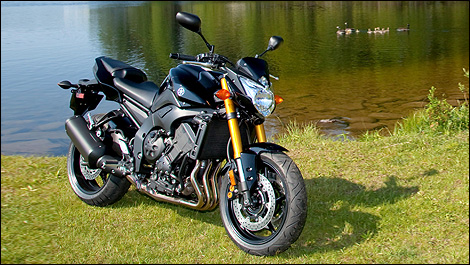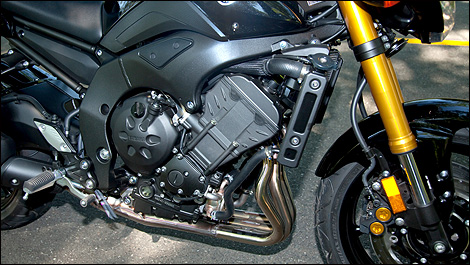Already popular in Europe, the FZ8 comes to our shores in two 2011 versions: the naked FZ8 Street Fighter and the semi-faired, touring-inclined Fazer 8. Both variants share the same engine and frame but have a slightly different personality.
 |
| I loved the FZ8's take-no-prisoners look, the gold fork and the mini windshield. (Photo: Yamaha) |
Their raison d’être is obvious, considering the success of sporty middleweight machines like the Kawasaki Z750, Triumph Street Triple and
Street Triple R,
BMW F800R and ST, as well as the various Ducati bikes hovering around 700 cc. Both 8 models benefit from every key feature that ensured the success of its predecessors here: style, torque, ease of use, lightness and versatility.
Aesthetically speaking, the two 8s fall somewhere between the FZ1 (still available) and the FZ6 (dropped in 2009). There are no flights of fancy here, simply nice clean lines, especially on the FZ8 which I particularly liked, with its contemporary and belligerent style that reminds you of a jaguar ready to pounce.
Intelligent engine size
Rather than pump up the engine and frame of the R6, whose extremely compact mill wasn’t suited to a 200-cc increase, Yamaha decided to use the FZ1 and its meatier 1000cc engine as the starting point. This 779cc, four valves per cylinder modern mill delivers 106.2 hp at 10,000 rpm and 60.8 ft-lb of torque at 8,000 rpm. The electronic injection system uses two injectors per cylinder, helped by a generous 7.8 litres airbox, and asymmetrical intake manifolds, as those for the middle cylinders are 28 mm longer than those on the outside. This gives the engine two inner cylinders that generate more torque, and two outers that focus on power. The result is a generous and constant wallop of torque across the entire power band on the road.
The 6-speed transmission inherited from the FZ1 has been given a different ratio to favour city riding (shorter 1st and 2nd ratios) and reduce rpm at higher speeds (longer 5th and 6th ratios). Shifting is just as precise and smooth as that of the parent system, while the clutch, which is lightened and features softer springs than the FZ1, proves progressive and easy to use.
 |
| The familiar R1 engine, leaned forward as always to make for nice vertical and super effective intake stacks. (Photo: Yamaha) |

